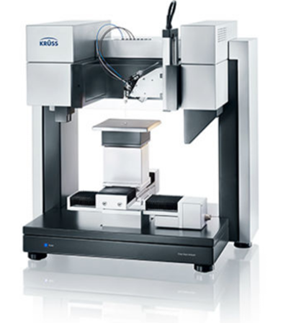Drop Shape Analyzer, DSA 100, Krüss

Several measurements with different scopes can be performed using this device. It is in general a device for the observation of droplets on different configurations, mainly sessile droplets from a side and a top view as well as hanging droplets. Hanging droplets from a needle deform in the typical pear shape. The precise shape of the hanging droplet is determined by its weight (density) and the interaction between the molecules conforming the fluid with the tip of the needle. These interactions are directly related to the surface tension of the fluid, which the software can provide by analysing the shape of the hanging droplet.
The observation of sessile droplets gives us information about how the fluid is interacting with the solid used as substrate. First, depending on the chemical properties of the surface and its roughness, we can find hydrophilic and hydrophobic materials. On hydrophilic materials water droplets will spread resulting in a contact angle fluid-surface smaller than 90 degrees. For hydrophobic surfaces, the water is repelled and the drop stays in a round configuration, the contact with the surface is minimised resulting in contact angles larger than 90 degrees. Using different fluids, one could determine the surface energy of the material.
The observation of droplets can also be interesting for the analysis of possible infiltration of the fluid in the substrate. This usually happens in materials such as paper, where the fluid infiltrates the pores of the material. Using the top view, the wetting front can be tracked. Using the side view, the evolution of the droplet volume over time can be determined. These observations may provide information on the homogeneity of the structure (for example possible orientation on the paper fibres) or even quantitative information such as porosity or pore size.
a. DSA100 by Krüss
b. General description
The DSA100 Drop Shape Analyzer enables the analysis of wetting and coating processes of solids and liquids. Using the pendant drop method, the software can determine the surface tension of a given liquid. Contact angle measurements provide information about solid-liquid interactions, which relates to different surface properties such as roughness or porosity. The droplet evolution gives us further insights on the microstructure of the material.
In addition, the device can be customised with the following modules:
- Top view module: it uses the top-view distance method for measuring the contact angle of a liquid on a solid from above. The innovative measuring method is particularly suitable for measurements in depressions and on concave surfaces where drops cannot be analysed using the usual side view. A further strength of the TVA100B lies in the especially high precision in the range of very low contact angles. It also offers a high precision micro-dosing system to deposit small quantities of liquid on surfaces.
- Humidity/Temperature chamber: it allows to work with temperatures up to 90 °C. The well-sealed and insulated plastic housing and a copper heat-conducting hood ensure stable thermodynamic equilibrium. Gas purging of the viewing window is effective against condensation. The dosing position can be conveniently adjusted from the outside when the chamber is closed and at the required temperature. Humidity can be chosen from 5% to nearly 99% relative humidity
- Application aim: measurement of surface tension and surface energy. Hydrophobicity/Hydrophilicity test and stability.
- Mobility: not mobile
- Equipment specifics:
- Fast camera
- Sample required: sampling is not necessary as long as the measurement can be performed at ambient conditions. Sample stage is 10x10 cm2, so smaller/narrower objects are not a problem. Larger objects need additional support. For humidity controlled measurements the sample size must not exceed the 10x10 cm2 as the humidity chamber is a closed environment. Notice that in this case there would be no room to move the sample and only measurements in the central area could be performed.
- Contact required: contact with a liquid is required. Pure water is usually employed, which can be removed from the surface but may alter the structure of some materials such as paper.
Interaction spot dimensions: each measurement is performed using small droplet size. The spreading of the drop over the surface is determined by the hydrophilicity of the material and may range from no spreading (minimal surface contact in the order of tenths of milimeters) to complete wetting that should not extend over a cm². - Application requirements: for humidity controlled measurements a nitrogen supply is required
- Limitations: size limits previously specified.
- Average time for measuring: when measuring with volatile liquids such as water the measurement takes from half a minute to several minutes depending on the focus of interest. Viscous liquids may take longer to infiltrate or spread.
- Average time for processing: contact angle images and videos can be exported in a matter of seconds. Dynamic measurements where the evolution of contact angle or droplet volume is of interest might take up to 1 hour to plot the data and fit them to the proper equations.
- Output: output images (.png, hundreds kB), output videos (.avi, 100fps, 1 min, ~1GB ), output tables (.xlsx, KB). Notice that the size of the videos may considerably differ as it heavily depends on the duration and the fps set. The videos can be processed afterwards to change the compression and frame rate (and make them lighter).
- Contacts: Laura Gallardo Dominguez, laura.gallardo"AT"tuhh.de
- Location of the equipment: Center for Hybrid Nanostructures (CHyN), DESY (Notkestraße 85, Hamburg)
